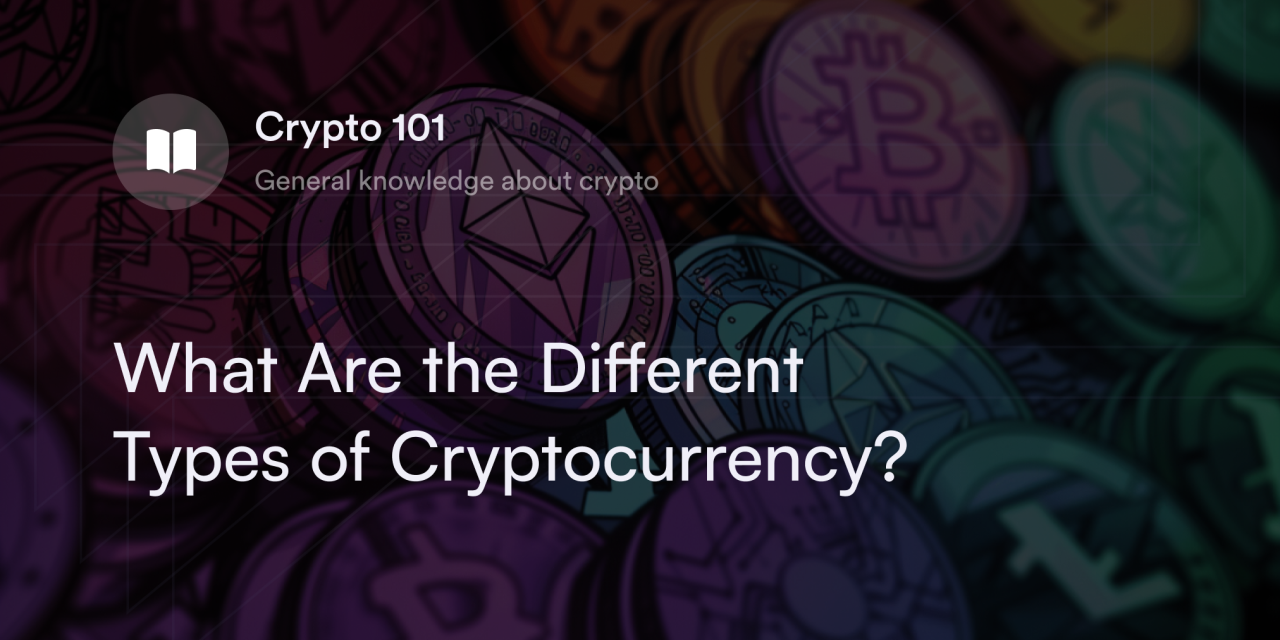


Two years after its 2009 launch, Bitcoin (BTC) became synonymous with cryptocurrency. It wasn’t until software engineer Charlie Lee created a new crypto coin called Litecoin (LTC) that an alternative to Bitcoin or altcoin entered the cryptocurrency market.
Today, there are far more than just two digital coins. Statistics highlight that more than 8,000 coins and tokens existed in the crypto ecosystem as of Feb 2023. Additionally, there are millions of non-fungible tokens (NFTs) as well in the hot crypto collectibles space.
With so many cryptocurrencies available, new traders often feel overwhelmed by the diverse use cases for various digital assets. So what are the different types of cryptocurrency, and how do traders distinguish between these categories?
What counts as a cryptocurrency?
The one feature all cryptocurrencies share is a reliance on decentralized computer networks called blockchains. These computers on a blockchain’s protocol are called nodes, which broadcast, store, and post info on digital payment records known as distributed ledgers. Although each cryptocurrency’s blockchain has different rules and coding standards, they process transactions using secure cryptographic technologies and record transfer data on virtual payment ledgers.
Bitcoin (BTC) is the largest, longest-lasting, and most influential virtual currency to use blockchain technology, but it wasn’t the first attempt at creating a decentralized digital currency. BTC’s founder and cryptographer, Satoshi Nakamoto, developed a proof-of-work (PoW) system where nodes reach consensus without relying on centralized intermediaries. In Bitcoin’s PoW model, nodes compete to post the next block of BTC transactions on the blockchain by solving complex math problems every 10 minutes. To incentivize Bitcoin miners, whoever solves these mini-puzzles the fastest gets a BTC reward in their crypto wallet.
Although Bitcoin’s PoW consensus algorithm inaugurated the cryptocurrency industry, digital assets don’t need this system to qualify as a cryptocurrency. For instance, many cryptocurrencies, such as Ethereum (ETH), use the proof-of-stake (PoS) system, where validators lock cryptocurrency on the blockchain to participate in the validation process. The essential feature every cryptocurrency needs is a reliance on distributed ledgers and decentralized networks of nodes that support peer-to-peer (P2P) transactions.
What are the different types of cryptocurrency?
Every cryptocurrency fits into one of two categories: coins or tokens. Although both use blockchain technology, only coins are built directly into a blockchain protocol’s infrastructure.
Bitcoin is a cryptocurrency coin because it exists within the core coding instructions for its blockchain. Tokens, in contrast, are add-on projects that leverage a preexisting blockchain’s security. Crypto developers often use smart contract programs to create or mint their tokens on a blockchain like Ethereum, Cardano (ADA), or Solana (SOL). Think of smart contracts as special software functions that automatically scan data on a blockchain and react according to their programming. If developers write a smart contract code compatible with their blockchain (e.g., the Solidity coding language on Ethereum), they can launch whatever token they want. Examples include Uniswap’s UNI, the stablecoin USD Coin (USDC), and Aave’s AAVE.
Besides their placement on or in a blockchain, coins and tokens have different potential use cases. Traders often use coins for on-chain transactions and to pay network fees on their protocols. Although users actively trade tokens on crypto exchanges, tokens have a far wider array of applications––from in-game rewards and digital collectibles to decentralized governance and virtual real estate, tokens generally have more utility than coins.
Types of cryptocurrency tokens
Cryptocurrency coins typically find application in P2P payments or trading, but tokens have a growing list of use cases. Reviewing a few of the most popular cryptocurrency token types helps new traders appreciate the innovations in this tech sector.
Stablecoins: A stablecoin is a cryptocurrency that mirrors a fiat currency’s price, such as the U.S. dollar or euro. Crypto traders use stablecoins to quickly exit and enter the crypto market or to explore trading opportunities in decentralized finance (DeFi) applications. Examples include USDC, Tether (USDT), and DAI.
Governance tokens: If a token gives holders voting rights on a blockchain protocol, it qualifies as a governance token. People with governance tokens––such as UNI, COMP, or AAVE––lock them in timed smart contracts to voice their opinions on upcoming proposals.
Wrapped tokens: When people wrap a cryptocurrency, they create a synthetic version of their original coin on a different blockchain network. Since each blockchain has unique coding standards, wrapping allows traders to send cryptocurrencies between protocols and use features on competing chains. For example, when people want to use Bitcoin in Ethereum’s ecosystem, they send their BTC to a custodian like BitGo and receive the ETH-compatible Wrapped Bitcoin (wBTC) token.
Non-fungible tokens (NFTs): NFTs are digital ownership rights with transparent blockchain addresses and distinguishing digital files. Although all virtual media works as NFTs, the most popular are profile pic avatar (PFP) collections. Examples include the Bored Ape Yacht Club (BAYC), CryptoPunks, and Cool Cats.
Utility tokens: Utility tokens serve a clear function in a Web3 ecosystem. For example, metaverse game The Sandbox has a SAND utility token that players use as an in-game currency.
How many types of cryptocurrency are there?
The number of cryptocurrencies is in constant flux, and new experimental categories like “Bitcoin Ordinals” and “soulbound tokens” constantly sprout in Web3. Although it’s impossible to say how many types of digital currencies exist at the time of writing, most recent statistics suggest there are approximately 10,000 cryptocurrencies in the digital assets market.
To find the latest info on the cryptocurrency count, traders scroll through the latest projects on crypto price aggregator websites, such as CoinMarketCap and CoinGecko. These reputable websites have long lists of cryptocurrencies and tabs to filter different segments of the crypto industry (e.g., metaverse tokens, AI tokens, and NFTs). Visiting the last few pages on these websites gives traders a sense of how many digital assets currently exist in the crypto ecosystem.
What are the most popular types of cryptocurrency?
It’s challenging to say which crypto category is the “most popular” at any given moment, just like tracking the number of cryptocurrencies. Fads like meme coins, PFP NFTs, and AI tokens spike or slump depending on the latest news and market dynamics. However, there are ways to quantify the popularity of different cryptocurrency types on exchanges and price aggregator sites.
For instance, studying volume charts is a common way traders decide which types of cryptocurrency to buy or sell. Volume charts measure how many coins or tokens exchanged hands within a given timeframe. If the bars on a volume graph are green and continue to grow in size, there’s surging demand for cryptocurrency. However, rising red bars on a volume chart suggest more selling activity in the crypto market. If volume levels remain subdued, chances are the underlying cryptocurrency isn’t hot at the moment. Although market conditions always fluctuate, established digital assets––such as Bitcoin, Ethereum, and USDC––tend to be the most actively traded digital assets.
Besides monitoring volume levels, sites like CoinMarketCap and CoinGecko post “Trending” cryptocurrencies on their home pages. Coins or tokens in this category tend to have a lot of social media hype, online search activity, and abnormally high trading volumes. These trending analytics help traders identify the crypto projects and categories with the most momentum in the market.
Explore dYdX’s expanding crypto perps portfolio
As crypto traders explore new crypto opportunities, dYdX continues to introduce new altcoin perpetual contracts to the decentralized exchange. Eligible traders with a dYdX account can access dozens of crypto perpetuals and advanced trading tools, such as slippage tolerance, stop-loss orders, and up to 20x leverage.
For more details on the coins and tokens available on dYdX’s exchange, check out our blog and Academy for the latest updates.
Eligible traders can start trading on dYdX today!
Disclosures
The opinions and information presented in this article (the “Article”) are provided for general information purposes only. Reference to any specific content, product, service, or entity does not constitute an endorsement or recommendation by dYdX Trading Inc., or any affiliate, agent, or representative thereof (“dYdX”). The content provided in this Article is for informational purposes and does not constitute, and should not be considered, or relied upon as, financial advice, legal advice, tax advice, investment advice, or advice of any other nature; and the information in this Article is not a call to action to make any investment, or purchase any crypto asset, of any kind (collectively, the “Service”). By using the Service, you agree that you are responsible to conduct independent research, perform due diligence, and engage a professional advisor prior to taking any financial, tax, legal, or investment action related to the subject matter hereof. You may only use the dYdX interface in compliance with the dYdX terms of use available here, including the geographic limitations therein.
Any applicable sponsorship will be disclosed, and any reference to a sponsor in this Article is for disclosure purposes, or informational in nature, and in any event is not a call to action to make an investment, acquire a service or product, or purchase crypto assets. This Article does not offer the purchase or sale of securities. By using the Service, you agree that dYdX is not responsible, directly or indirectly, for any damage or loss incurred by you in connection with the use of or reliance on the Service, including any content, products, services, or entity mentioned in this Article.







